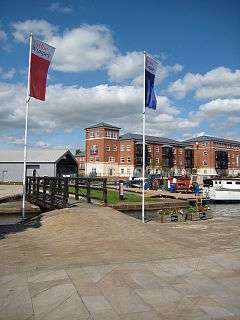Taylor Wimpey
Taylor Wimpey plc (formerly Taylor Woodrow plc) is one of the largest British based housebuilding companies. It is listed on the London Stock Exchange and is a constituent of the FTSE 100 Index. Its operational headquarters in the United Kingdom are in High Wycombe.
 | |
| Public limited company | |
| Traded as | LSE: TW. FTSE 100 Component |
| ISIN | GB0008782301 |
| Industry | Housebuilding |
| Founded | 2007 |
| Headquarters | High Wycombe, Buckinghamshire |
Key people |
|
| Revenue | £4,341.3 million (2019)[1] |
| £842.5 million (2019)[1] | |
| £673.9 million (2019)[1] | |
| Website | www.taylorwimpey.co.uk |
The company was created from the merger of rivals Taylor Woodrow and George Wimpey on 3 July 2007.[2]
History
Taylor Woodrow
Taylor Woodrow was founded in 1921, by 16 year old Frank Taylor, who borrowed some money to build two houses in Blackpool. As he was too young to form his own company, his uncle Jack Woodrow lent his name to the business, and so it became Taylor, Woodrow Limited.[3]
In the 1930s, Taylor Woodrow diversified into building temporary hospitals etc., and thereby moved into general construction.[3] Taylor Woodrow's main operations were in general construction with Taylor Woodrow Homes only being a small part of the group: indeed, housing sales actually declined, and at the beginning of the 1980s, Taylor Woodrow Homes was still only building around 500 to 600 houses a year.[4]
In January 2001, this changed as Taylor Woodrow acquired Bryant Group, a business founded in Birmingham in 1885 by Chris Bryant, for £556 million[5] and in October 2003 Taylor Woodrow acquired Wilson Connolly in a cash and shares deal worth £499 million.[6]
George Wimpey

George Wimpey was founded by George Wimpey and Walter Tomes (the latter sold out in 1893) as a stone-working partnership in 1880 in Hammersmith.[3]
George Wimpey died in 1913 at the age of 58. His family put the business up for sale in 1919. Godfrey Way Mitchell bought the firm and decided to retain the Wimpey name.[3] George Wimpey completed its first residential development, the Greenford Park Estate, in 1928.[3]
In the 1970s, George Wimpey became the United Kingdom's largest private house builder selling 106,440 homes in the decade, and in the 1980s, George Wimpey began to reinforce Wimpey Homes as a brand, focusing on quality compact housing. Advertising, featuring the famous Wimpey cat, ensured Wimpey Homes became a household name in house building.[7]
In March 1996, George Wimpey acquired McLean Homes, a business founded in the 1934 by John McLean, from Tarmac.[8] In August 2001, McAlpine Homes was acquired from Alfred McAlpine in a £463 million deal[9] and in October 2002, George Wimpey went on to acquire Laing Homes, a premium housebuilder, from John Laing for £295 million.[10]
Post-merger
In September 2008, Vinci bought the operations of Taylor Woodrow Construction[11] and in April 2009, the remaining activities of Taylor Woodrow Construction in Ghana were sold to management.[12] Then in March 2011, a property investment group backed by private equity firms acquired Taylor Wimpey's American and Canadian housebuilding businesses.[13]
COVID-19 lockdown
On 23 March 2020, Taylor Wimpey "shut all its UK sites and sales centres ... following prime minister Boris Johnson's announcement of lockdown measures" in response to the COVID-19 pandemic in the United Kingdom.[14] Six weeks after shutting down, the firm claimed to be "the first major housebuilder to unveil a timetable for restarting jobs", and said it would begin remobilisation in England and Wales on 4 May 2020.[15] Taylor Wimpey said that although all its show homes had been closed during the lockdown, sales had continued. "[T]otal orders grew by 200 during the shutdown to reach 10,880 homes, up from 10,291 in the order book a year ago."[14] Taylor Wimpey has also been busy running a manufacturing project with employees to supply "GP surgeries and care homes with reusable 3D printed face visors".[15]
In July 2020, Taylor Wimpey reported a £40m loss in the first half of 2020 mainly due to the impact of COVID-19 lockdown. Revenue more than halved to £754m. Completions fell 58% to 2,771 homes, compared to 6,541 during the first half of 2019.[16]
Operations
Taylor Wimpey's United Kingdom operations are increasingly focused on the Taylor Wimpey brand with historic brands (Bryant Homes, George Wimpey, Laing Homes and G2) being phased out. Taylor Wimpey's corporate head office is located at Gate House in High Wycombe. There are 24 regional offices in the United Kingdom.[17]
Taylor Wimpey is headed up by Pete Redfern who has been CEO of the company since July 2007.[18]
The company completed a total of 6,541 homes in the first half of 2019, compared with 6,497 in 2018.[19]
Sponsorships and awards
Taylor Wimpey was the main sponsor of St Johnstone F.C., for the football seasons of 2009 to 2011.[20]
In 2016 Taylor Wimpey held its Project 2020 Open Design Competition in an attempt to find a design for a "home of the future". The project was launched in partnership with RIBA.[21]
Ground rent scandal
Taylor Wimpey has been accused of selling "recently-built" houses and apartments as leasehold that would traditionally have been freehold, with clauses that allow the ground rent to rise dramatically in later years. This makes the houses unsaleable.[22] Taylor Wimpey has also sold the freehold to other companies, which can then go on to charge exorbitant amounts (up to £40,000) for the freehold.[23]
References
- "Results for the year ended 31 December 2019". Taylor Wimpey. Retrieved 28 February 2020.
- "BBC NEWS – Business – Wimpey and Woodrow agree to merge". bbc.co.uk. Retrieved 21 March 2015.
- Taylor Wimpey: Our History
- Wellings, Fred: Dictionary of British Housebuilders (2006) Troubador. ISBN 978-0-9552965-0-5
- "BBC News – BUSINESS – Taylor Woodrow buys up Bryant". bbc.co.uk. Retrieved 21 March 2015.
- Stevenson, Rachel (1 September 2003). "Taylor Woodrow to buy Wilson Connolly". The Independent. Retrieved 24 October 2017.
- "History". George Wimpey. Retrieved 26 March 2016.
- British home builders to swap some assets
- "BBC News – BUSINESS – Wimpey buys McAlpine building unit". bbc.co.uk. Retrieved 21 March 2015.
- "Wimpey takes over again as UK's biggest housebuilder with £300m Laing deal". The Independent. Archived from the original on 27 June 2014. Retrieved 21 March 2015.
- "Acquisition: Vinci buys Taylor Woodrow". nce.co.uk. Retrieved 21 March 2015.
- Investor Group acquires Taylor Woodrow of Ghana Ltd from Taylor Wimpey PLC through a leveraged buyout Reuters, 21 April 2009
- Taylor Wimpey sells American business for £595m The Telegraph, 31 March 2011
- Bingley, Lem (23 April 2020). "Taylor Wimpey eyes 80% output amid plans to reopen sites". Construction News. Retrieved 13 May 2020.
- Rogers2020-04-23T07:16:00+01:00, Dave. "Taylor Wimpey to start reopening sites next month". Building. Retrieved 13 May 2020.
- Morby, Aaron (29 July 2020). "Covid impact plunges Taylor Wimpey to £40m loss". Construction Enquirer. Retrieved 29 July 2020.
- "Office Addresses". Taylor Wimpey plc. 2011. Retrieved 6 October 2012.
- "Monday Interview: Pete Redfern has rebuilt Taylor Wimpey, he doesn't want another bubble". The Telegraph. 30 June 2013. Retrieved 6 October 2017.
- Mancini, Donato Paolo (31 July 2019). "Profits and margins slip at housebuilder Taylor Wimpey". www.ft.com. Retrieved 13 December 2019.
- "Football shirt Forum :: Topics in FSC Forum (1/1)". footballshirtculture.com. Archived from the original on 2 April 2015. Retrieved 21 March 2015.
- "Finalist schemes in Taylor Wimpy house of the future contest". Architect's Journal. Retrieved 23 November 2016.
- The ground rent scandal that is engulfing new home buyers
- The new-builds catching house buyers in a leasehold property trap